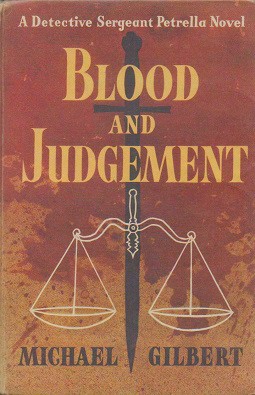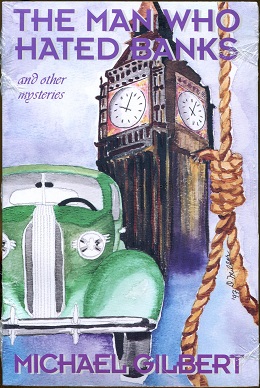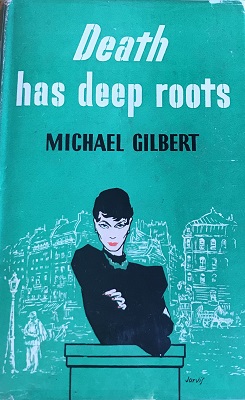Michael Francis Gilbert was an English solicitor and author of crime fiction.

Smallbone Deceased is a 1950 mystery novel by the English author Michael Gilbert, published in the United Kingdom by Hodder and Stoughton and in the United States by Harper & Brothers. A practising lawyer himself, Gilbert made the setting of the novel a London solicitor's office. The book was Gilbert's fourth novel and, like his three earlier ones, features Chief Inspector Hazlerigg. The novel was well-received and has regularly appeared in "Top 100" crime lists. Some critics consider it to be Gilbert's best work.

Close Quarters is the first novel by the British mystery writer Michael Gilbert. Published in England by Hodder and Stoughton in 1947, it did not appear in the United States until 1963. By then Gilbert's reputation had been firmly established in both countries and his regular American publisher for many years had been Harper & Brothers. Close Quarters, however, was published by Walker and Company, a less prestigious house. In it we are introduced to Chief Inspector Hazlerigg, who will go on to be a recurring character in a number of Gilbert's works throughout the next ten years. Gilbert, who was appointed CBE in 1980, was a founder-member of the British Crime Writers' Association. The Mystery Writers of America named him a Grand Master in 1988 and in 1990 he was presented Bouchercon's Lifetime Achievement Award.

Blood and Judgement is a police procedural novel by the British author Michael Gilbert. Published in England in 1959 as Blood and Judgement by Hodder and Stoughton and in the United States as Blood and Judgment by Harper & Brothers, it was Gilbert's tenth novel. Gilbert, who was appointed CBE in 1980, was a founder-member of the British Crime Writers' Association. The Mystery Writers of America named him a Grand Master in 1988 and in 1990 he was presented Bouchercon's Lifetime Achievement Award. It introduces his most notable series character, Patrick Petrella, as a young and already somewhat controversial Detective Sergeant working out of the fictional Q Division of the Metropolitan Police Area.

Fear to Tread is a mystery–crime thriller by the British mystery writer Michael Gilbert, first published in 1953 by Hodder and Stoughton in England and by Harper & Brothers in the United States. Set mostly in London, it was his seventh novel in six years and built upon the favourable reputation he had achieved earlier with the well-received Smallbone Deceased and Death Has Deep Roots. Gilbert, who was appointed CBE in 1980, was a founder-member of the British Crime Writers' Association. The Mystery Writers of America named him a Grand Master in 1988 and in 1990 he was presented Bouchercon's Lifetime Achievement Award. It is one of numerous stories and novels by Gilbert presenting a gritty, realistic depiction of organized gangs, frequently directed by a deeply concealed mastermind who is not unearthed until the final pages.

Stay of Execution is a collection of mystery stories by the British thriller writer Michael Gilbert, first published in 1971 by Hodder & Stoughton. Gilbert, who was appointed CBE in 1980, was a founder-member of the British Crime Writers' Association. The Mystery Writers of America named him a Grand Master in 1988 and in 1990 he was presented Bouchercon's Lifetime Achievement Award. Unusually for a collection of stories, its reprint edition by House of Stratus in 2011 has no index detailing the stories in the book. The longest story, by far, is the last one in the book, Stay of Execution. At 54 pages, it is what is generally called a novella. Two of the stories feature Chief Superintendent Hazlerigg; three Henry Bohun; and one Detective Inspector Petrella, characters who have figured in other short stories and novels by Gilbert. The Independent said of the book in 2006:
Gilbert had a fondness for amusing but unscrupulous pirates... and an entirely practical, indeed sceptical, view of the workings of the law. It was typical of his humour that the two stories in his excellent collection Stay of Execution (1971) in which rascally solicitors "get away with it", "Back on the Shelf" and "Mr Portway's Practice", were written in the first person.

Anything for a Quiet Life and Other New Mystery Stories is a collection of nine short stories by the British writer Michael Gilbert published in the United Kingdom by Hodder and Stoughton in 1990 and in the United States by Carroll & Graf the same year. Gilbert, who was appointed CBE in 1980, was a founder-member of the British Crime Writers' Association. The Mystery Writers of America named him a Grand Master in 1988 and in 1990 he was presented Bouchercon's Lifetime Achievement Award. All nine stories had previously appeared in Ellery Queen's Mystery Magazine. All of them take place in a fictional English coastal town called Shackleton-on-Sea that is situated in the south of England not far from Brighton and Hove. In spite of Gilbert's usual low-key urbanity in his style, a number of them have an unexpected grimness about them. "Michael was an exceptionally fine storyteller, but he's hard to classify," said one of his British publishers after his death. "He's not a hard-boiled writer in the classic sense, but there is a hard edge to him, a feeling within his work that not all of society is rational, that virtue is not always rewarded.".

The Man Who Hated Banks is a collection of mystery stories by the British thriller writer Michael Gilbert, first published in 1997 by the American company Crippen & Landru. As the back cover of the book tells us, it was "published in honour of the fiftieth anniversary of Michael Gilbert's first book." Gilbert, who was appointed CBE in 1980, was a founder-member of the British Crime Writers' Association. The Mystery Writers of America named him a Grand Master in 1988 and in 1990 he was presented Bouchercon's Lifetime Achievement Award. It has an Introduction by the author and contains 18 of his previously uncollected stories, all of them concerning characters who have figured in other novels and short stories. Seven of the stories feature Chief Inspector Hazlerigg; five Henry Bohun; three Detective Chief Inspector Mercer; and three Detective Inspector Petrella.
Inspector Hazlerigg is a police detective created by the British mystery writer Michael Gilbert who appears in six novels published between 1947 and 1958, as well as in 20 short stories. Although he plays a key role in each of the novels, he is far from being the main character in all of them; in some, particularly Death Has Deep Roots and Fear to Tread, his page appearances are quite limited. In his first appearance, in the Golden Age mystery novel Close Quarters, which takes place in 1937, Hazlerigg is a Chief Inspector at New Scotland Yard in London. By the final novel in the series, Fear to Tread, he has become a Chief Superintendent.

They Never Looked Inside is the second novel by the British mystery writer Michael Gilbert. It was published in England by Hodder and Stoughton in 1948 and in the United States by Harper & Brothers in 1949 as He Didn't Mind Danger. It was Gilbert's first publication in the States. It is also the second novel to feature Gilbert's earliest recurring character, Inspector Hazlerigg. Gilbert, who was appointed CBE in 1980, was a founder-member of the British Crime Writers' Association. The Mystery Writers of America named him a Grand Master in 1988 and in 1990 he was presented Bouchercon's Lifetime Achievement Award.

Amateur in Violence is a collection of mystery stories by the prominent British thriller writer Michael Gilbert, published in the United States in 1973 by Davis Publications, a publishing house for magazines, but not in England. Gilbert, who was appointed CBE in 1980, was a founder-member of the British Crime Writers' Association. The Mystery Writers of America named him a Grand Master in 1988 and in 1990 he was presented Bouchercon's Lifetime Achievement Award. The book is edited, and has an introduction, by Ellery Queen, the founder and long-term editor of Ellery Queen's Mystery Magazine. It contains 10 stories and a short novel that had been previously uncollected in the United States. Some of them feature characters who have figured in other novels and short stories by Gilbert. Three stories feature Inspector Hazlerigg and four Inspector Petrella. The short novel, "Stay of Execution", had previously given its name to the title of a collection published in England in 1971.

The Mathematics of Murder: A Fearne & Bracknell Collection, is a collection of mystery short stories by the prominent British thriller writer Michael Gilbert, first published in the United Kingdom by Robert Hale in 2000 when Gilbert was 88 years old but still an active writer. Gilbert, who was appointed CBE in 1980, was a founder-member of the British Crime Writers' Association. The Mystery Writers of America named him a Grand Master in 1988 and in 1990 he was presented Bouchercon's Lifetime Achievement Award.

A Pity About the Girl and Other Stories is a collection of mystery stories by the British thriller writer Michael Gilbert, first published in 2008 by the British company Robert Hale and unpublished in the United States. It contains 14 previously uncollected stories, as well as an introduction by John Cooper and two appendices. Some of the stories feature one or another of Gilbert's many recurring characters that he created throughout his long career of writing both novels and short stories. Gilbert, who was appointed CBE in 1980, was a founder-member of the British Crime Writers' Association. The Mystery Writers of America named him a Grand Master in 1988 and in 1990 he was presented Bouchercon's Lifetime Achievement Award. The locales vary from London to Latin America and the time frame from the present back to the Victorian days of Sherlock Holmes. A number of them, such as the title story, "A Pity About the Girl", and the two concerning Colonel Cristobal Ocampas, have an unexpected grimness about them. "Michael was an exceptionally fine storyteller, but he's hard to classify," said one of his British publishers after his death. "He's not a hard-boiled writer in the classic sense, but there is a hard edge to him, a feeling within his work that not all of society is rational, that virtue is not always rewarded". This is particularly true of the last story in the collection, "By The Pricking of My Thumbs".

The Curious Conspiracy is a collection of mystery stories by the British thriller writer Michael Gilbert, first published in 2002 by the American company Crippen & Landru and then in England. Published to recognize Gilbert's 90th birthday, it contains 20 previously uncollected stories, as well as a brief introduction by Gilbert himself and an appendix for Sources. Gilbert, who was appointed CBE in 1980, was a founder-member of the British Crime Writers' Association. The Mystery Writers of America named him a Grand Master in 1988 and in 1990 he was presented Bouchercon's Lifetime Achievement Award. Four of the stories in this collection feature two of Gilbert's many recurring characters that he created throughout his long career of writing both novels and short stories. Gilbert's introduction says that the topics covered by the stories are "catholic", in the sense of being "of universal human interest; touching the needs, interests or sympathies of all men." The locales vary from London to a Red Sea sheikdom and the time frame from the present day back to the Peninsular War. Some of them, such as "Judith", have an unexpected grimness about them. "Michael was an exceptionally fine storyteller, but he's hard to classify," said one of his British publishers after his death. "He's not a hard-boiled writer in the classic sense, but there is a hard edge to him, a feeling within his work that not all of society is rational, that virtue is not always rewarded.".

Even Murderers Take Holidays and Other Mysteries is a collection of mystery stories by British thriller writer Michael Gilbert, first published in 2007 by the British company Robert Hale and unpublished in the United States. It contains 25 previously uncollected stories, as well as an introduction by John Cooper and an appendix. The first twelve stories feature Inspector Petrella, one of the many recurring characters that Gilbert created throughout his long career of writing both novels and short stories. Its next story has Mr. Calder and Mr. Behrens, and there are four stories about Inspector Hazlerigg. Gilbert, who was appointed CBE in 1980, was a founder-member of the British Crime Writers' Association. The Mystery Writers of America named him a Grand Master in 1988 and in 1990 he was presented Bouchercon's Lifetime Achievement Award. The locales are mostly set in London and its environs. A number of the stories, such as "Somebody" and "Old Mr Martin", have an unexpected grimness about them. "Michael was an exceptionally fine storyteller, but he's hard to classify," said one of his American publishers after his death. "He's not a hard-boiled writer in the classic sense, but there is a hard edge to him, a feeling within his work that not all of society is rational, that virtue is not always rewarded."

Death Has Deep Roots is the fifth novel by the British mystery writer Michael Gilbert. It was published in England by Hodder and Stoughton in 1951 and in the United States by Harper & Brothers in 1952. It is basically a classical courtroom trial story but with almost equally important thriller elements juxtaposed with the courtroom scenes. Although Inspector Hazlerigg, who had appeared in all of Gilbert's earlier novels as a mostly leading character, does play a role in this story, it is only in two brief appearances, once towards the beginning of the book and once again near the end. Two of the three main characters in this book are from previous novels, Major Angus McMann and Noel Anthony Pontarlier ("Nap") Rumbold. The other leading character, the trial barrister Hargest Macrae, also appears in some of Gilbert's early short stories.

The Man Who Could Not Sleep and Other Mysteries is a collection of radio plays by the British thriller writer Michael Gilbert, first published in 2011 by the British company Robert Hale and unpublished in the United States. It contains two long, previously uncollected radio plays, as well as synopses of two proposed stage plays that were never subsequently written. It also has an introduction by John Cooper and three appendices. The locales of the plays are mostly in London and its environs. Two of the many recurring characters that Gilbert created over his exceedingly long writing career, Nap Rumbold and Hargest Macrea, are in "The Game Called Justice". As usual with Gilbert, the tone of the stories is civilized and even occasionally light-hearted, but there are always elements of bleakness beneath the urbane surface, particularly in "The Last Chapter". "Michael was an exceptionally fine storyteller, but he's hard to classify," said one of his American publishers after his death. "He's not a hard-boiled writer in the classic sense, but there is a hard edge to him, a feeling within his work that not all of society is rational, that virtue is not always rewarded.". Gilbert, who was appointed CBE in 1980, was a founder-member of the British Crime Writers' Association. The Mystery Writers of America named him a Grand Master in 1988 and in 1990 he was presented Bouchercon's Lifetime Achievement Award.

Death in Captivity is a mystery novel by the British crime writer Michael Gilbert, first published in the United Kingdom in 1952 by Hodder and Stoughton and in the United States by Harper & Brothers as The Danger Within. It was Gilbert's sixth novel and, unlike his previous ones, does not feature Chief Inspector Hazlerigg in any way. Nor is it set in Gilbert's usual locales of London, the English countryside, or France. Instead, while it has many of the elements of the classic detective story, it is also a gripping novel of mounting suspense that takes place in a 1943 prisoner of war camp for British officers in northern Italy—it was the first of Gilbert's numerous later works that would feature suspense and danger as much or more as elements of detection. Gilbert himself had been a British officer during the war, was captured, and interned in an Italian camp. He escaped and spent several months making his way through the Italian countryside trying to reach the British lines. Much of this book apparently reflects his own experiences. It was the basis of a 1959 British film, Danger Within, that closely followed the events in the book. H.R.F. Keating, who wrote Gilbert's obituary for The Guardian, said that "Gilbert's time as a PoW prompted Death In Captivity (1952), surely the only whodunnit set in a prisoner-of-war camp."

Ring of Terror is a mystery-suspense novel by the British crime writer Michael Gilbert, first published in the United Kingdom in 1995 by Hodder and Stoughton and in the United States by Carroll & Graf. It was Gilbert's 28th novel and the first of three featuring his final set of recurring characters, Luke Pagan and Joe Narrabone. Set in the reign of Edward VII, during the first decade of the 20th century, it was also the first of Gilbert's historical mysteries. Along with its fictional characters and situations, there are references to actual events of the time, such as the Siege of Sidney Street, and Winston Churchill plays a minor role as Home Secretary. Gilbert, who was appointed CBE in 1980, was a founder-member of the British Crime Writers' Association. The Mystery Writers of America named him a Grand Master in 1988 and in 1990 he was presented Bouchercon's Lifetime Achievement Award.
Inspector Bill Mercer is a detective created by the British crime and mystery writer Michael Gilbert. He is the leading character in the 1972 novel The Body of a Girl, a somewhat hardboiled police procedural, and appears later in at least three short stories. On the first page of the novel, "Detective Inspector William Mercer received... confirmation of his promotion to chief inspector and his appointment in charge of the CID at Stoneferry on Thames, which is one of the larger upriver stations of Q Division of the Metropolitan Police."

















